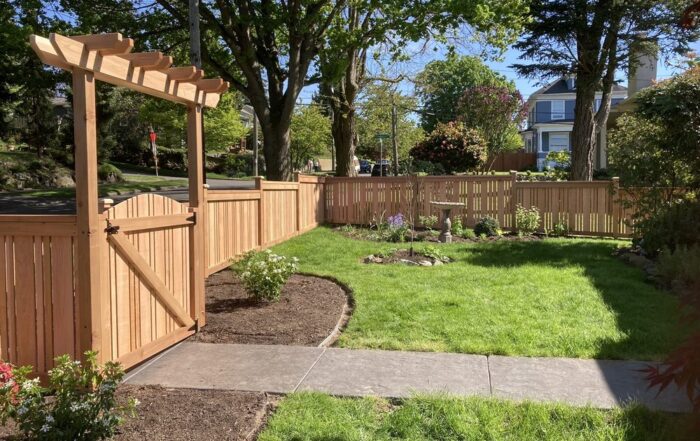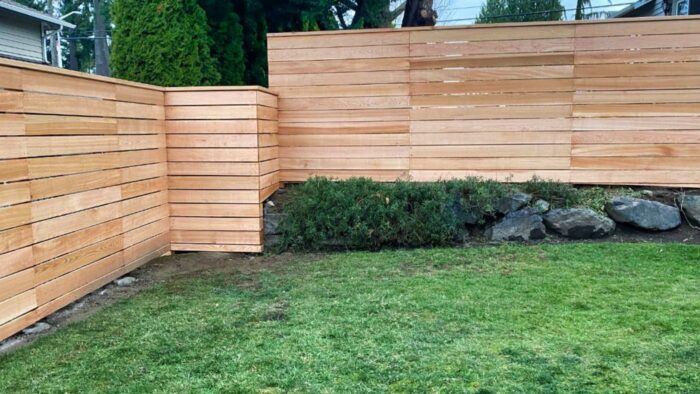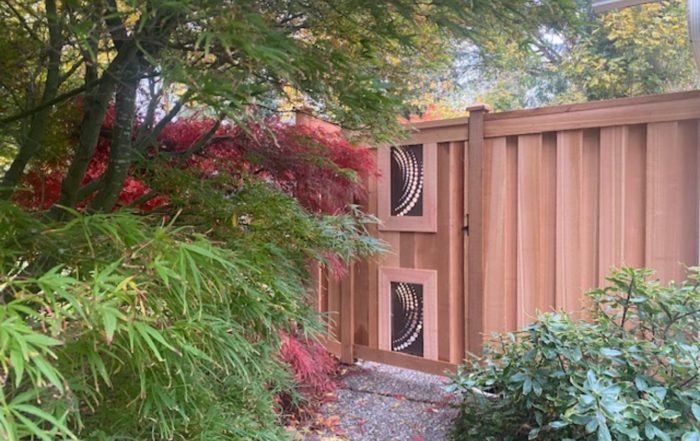Understanding Home Valuation
The data is in, and Seattle homes with fences have a distinct advantage when it comes time to sell!
You may ask yourself ‘Why is that? I thought it was all about things like square footage, mountain views, and kitchen upgrades. The truth is it’s a multifactorial equation that considers a number of elements, including the location, age, interior updates, and yes, even your outdoor enhancements, such as fences.
While each of these components individually contributes to the total value, it’s their combined effect that truly shapes the final price tag. So, let’s dive in, break down these factors, and see just how much value your fence can add to your Seattle property.

The Allure of a Fence
Practical Benefits and Psychological Appeal of a Fence
Sure, from the get-go, a fence is a smart choice for your home. Why? Well, for starters, it neatly defines your property—something house hunters always give a nod of approval to. Plus, it acts as a solid shield, warding off any unwanted visits, whether from a surprise human guest or the overly curious neighbor next door.
But here’s the kicker: a fence isn’t just a functional addition. It’s got this awesome power of evoking feelings. You see, it carves out a private nook in this vast world, making you feel like you’ve got a special corner all to yourself. There’s this undeniable charm in thinking, “This is my slice of the universe.” And hey, many are willing to shell out a bit extra for that precious feeling.
Think of your fence like a book jacket. It’s the first impression, setting the stage for the story within your home. And trust me, you want that narrative to start on the right foot.
Unveiling the Data: Insights from NWMLS
The dataset we’re using comes from the NWMLS, which details Seattle’s housing market for the third quarter of 2022. The data covers single-family homes and all feature attributes provided by the MLS. The data sample includes a list of the 1882 homes sold with 95 distinct features. We will be focusing primarily on Site Features, List Date, Sold Date, Days on Market (DOM), List Price, and Sold Price.
Assumptions: Homes with no reference to a fence, specifically homes not listed as fully or partially fenced, are presumed to be unfenced.
Average Days on Market for fully or partially fenced, and non-fenced properties
Imagine you’re selling your home. The clock starts ticking the moment your property is listed. If your home is sold after 30 days, then its DOM is 30. It’s a handy little number that tells us how quickly homes are flying off the market.
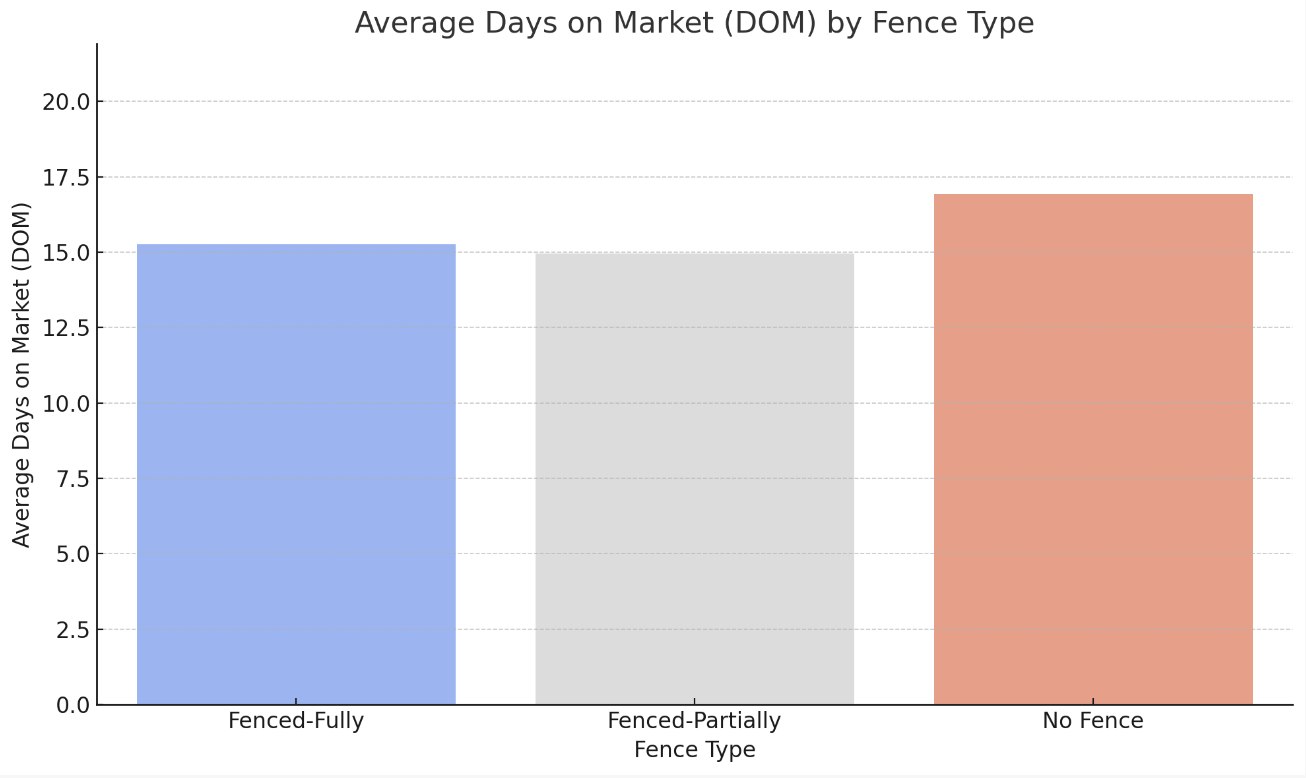
Bar chart showing the average Days on Market (DOM) by fence type.
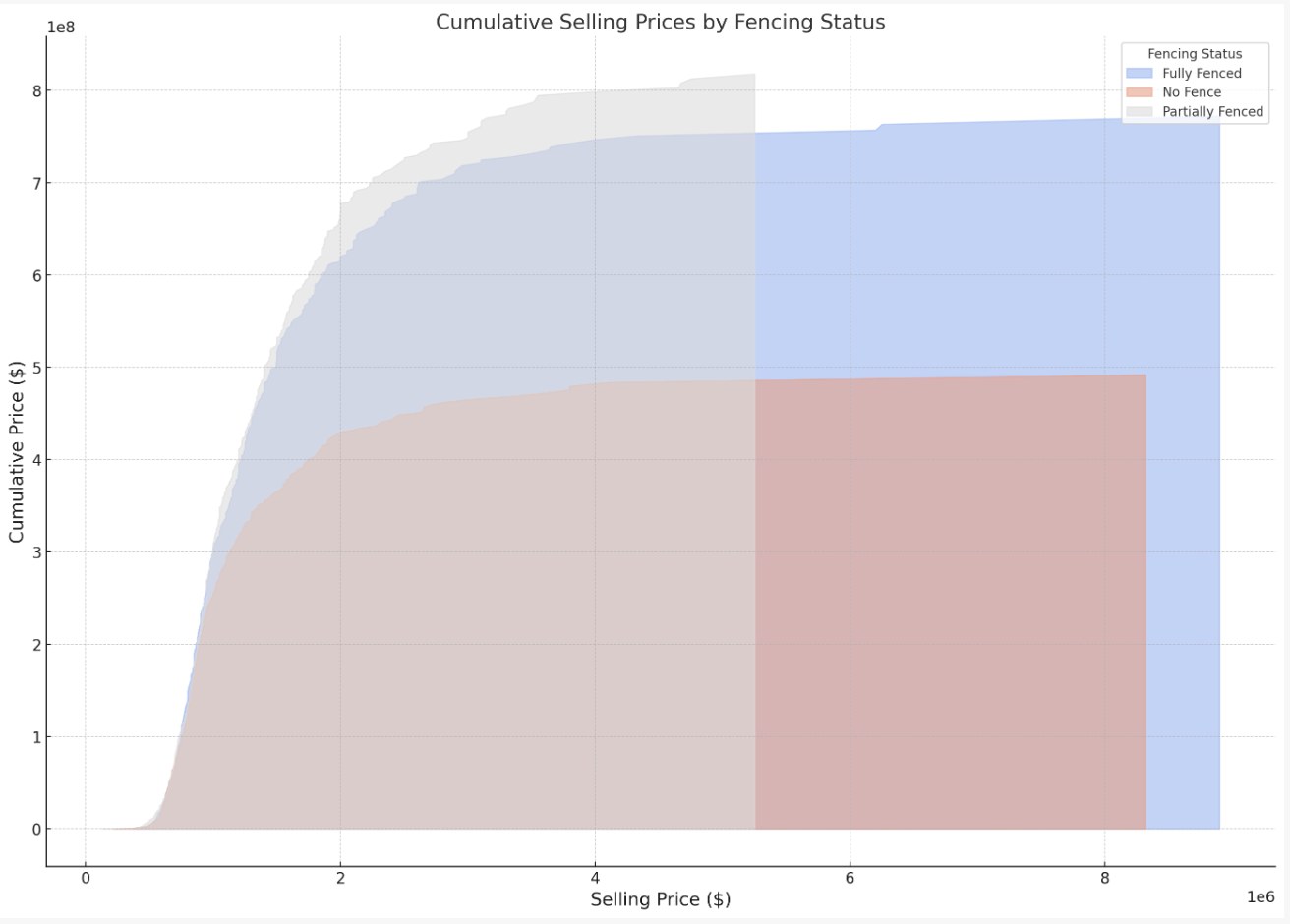
Area chart showing the cumulative selling prices by fencing status
From this analysis, we can infer the following:
Fencing’s Popularity:
- Homes with a partial fence: 715 sales.
- Those with a full fence: 678 sales.
- And homes without fences? They’re at 488 sales.
Average Days Waiting for a Buyer:
- Homes without fences? They tend to wait around an average of 16.9 days.
- Homes sporting a full fence? They’re off the market in about 15.3 days.
- Homes with partial fencing? They’re leading the pack, sealing the deal in roughly 14.9 days.
Median Market Days:
- Both the partially fenced and the fence-free homes share a sweet spot, with half selling within 8 days.
- Homes with full fencing? They’re a day quicker on the draw, with half selling in 7 days.
Economic Implications for home buyers and sellers:
- Higher Liquidity for Fenced Properties: Properties with either full or partial fencing tend to sell faster than those without fences. This suggests that there’s possibly a higher demand or preference among buyers for fenced properties.
- Potential Economic Advantage for Sellers: Sellers with fenced properties might have an economic advantage since faster-selling properties can reduce holding costs (like mortgage interest, utilities, and other carrying costs) and can lead to quicker capital recovery.
- Buyer Preferences: The data might indicate a buyer’s preference for privacy, security, or the aesthetic value that fences add to a property, leading them to make quicker purchase decisions for properties with fences.
Average Days on Market with Confidence Intervals
What are Confidence Intervals? Let’s think of confidence intervals as the safety net of our number-crunching world. Let’s say you’re trying to figure out the average height of folks in your town. You round up a handful of people, do a quick measure, and get an average. But deep down, you know there’s room for error, right? Think of the confidence interval as your trusty sidekick whispering, “Hey, the real average height? It’s probably between this height and that one.” It’s like a wink and nudge to remind you there’s a bit of wiggle room in those figures.
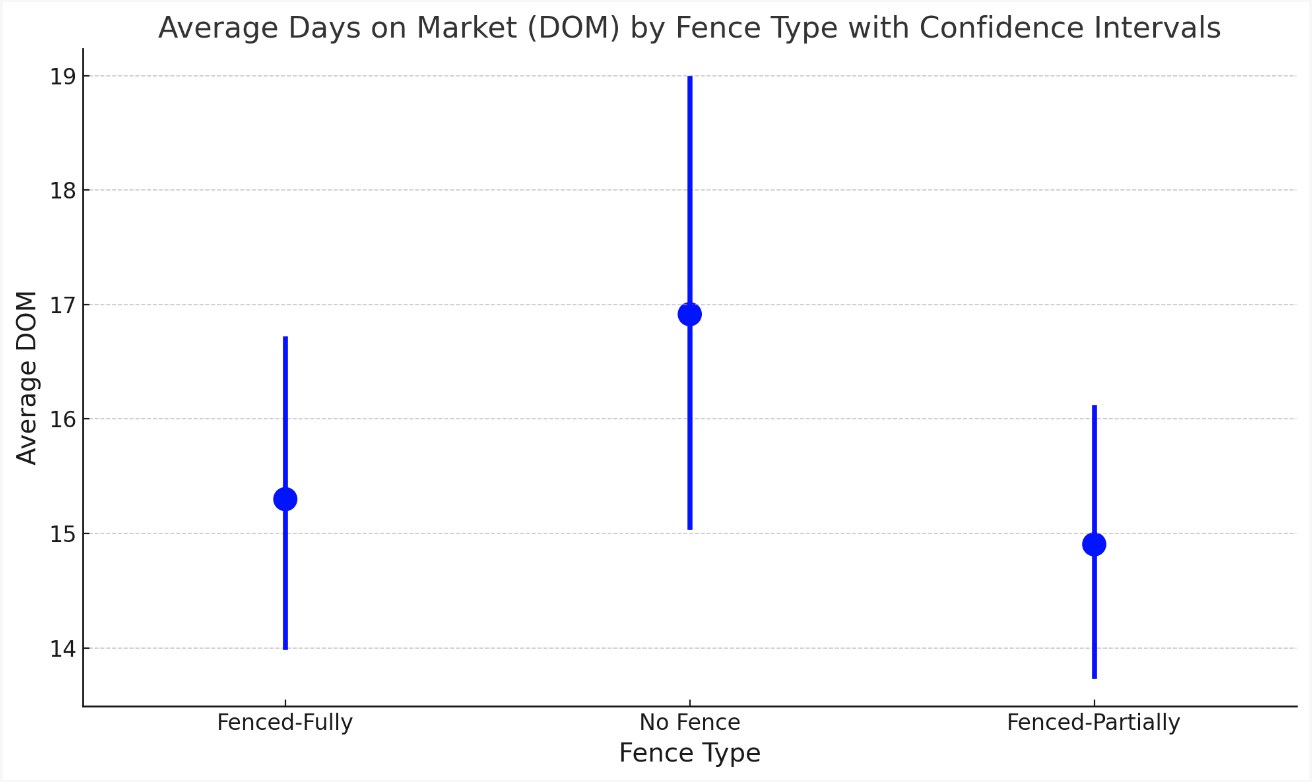
Dot Plot illustrating the Average Days on Market (DOM) for each fence type with confidence intervals
What do the confidence intervals tell us about average days on market?
Homes Surrounded by Fences: They’re typically on the market for a tad over 10 days. However, our trusty confidence interval hints that the true average might wobble anywhere from just below 10 days to possibly 12 days.
Homes Sporting a Bit of Fencing: These homes tend to linger around the 14-day mark. But, the confidence interval whispers a small secret – the real range might stretch between 13 and a touch past 15 days.
Our Open-Plan, No-Fence Homes: These ones? They’re hovering around 18 days on average. But throw in the confidence interval, and we’re looking at a span from close to 16 days and maybe tipping 19.

Median Sold Price for each fence with confidence intervals
What do the confidence intervals tell us about median sold prices of homes based on their fence type
Fully Fenced Homes: So, for homes wrapped up with a complete fence, the middle-of-the-road selling price seems to be a tad over $600,000. However, those green bars (yep, the confidence interval) hint that the actual “middle” price could wiggle up or down a bit.
Partially Fenced Homes: For homes that opted for a bit of an “open concept” in their yard, the median selling price appears to be just shy of $600,000. And guess what? Our confidence in this price is pretty strong, given the tighter green bars.
Homes Without Fences: No-fence homes? Well, they’re typically trading hands for around $550,000. And just like the half-fenced homes, we’re feeling fairly sure about this number.
So, what’s the takeaway? Fences might just have more to say about home prices than we thought! But remember, it’s always the big picture that counts.
What do the confidence intervals tell us about Median Sold Price for each fence type?
The Big Picture: Fence Data and the Distribution of DOM
Now that we’ve looked at the DOM let’s zoom out and take a look at the bigger picture of the city’s home-selling pace. Our next chart will shed light on whether Seattle’s fenced properties are flying off the market or taking a leisurely stroll.
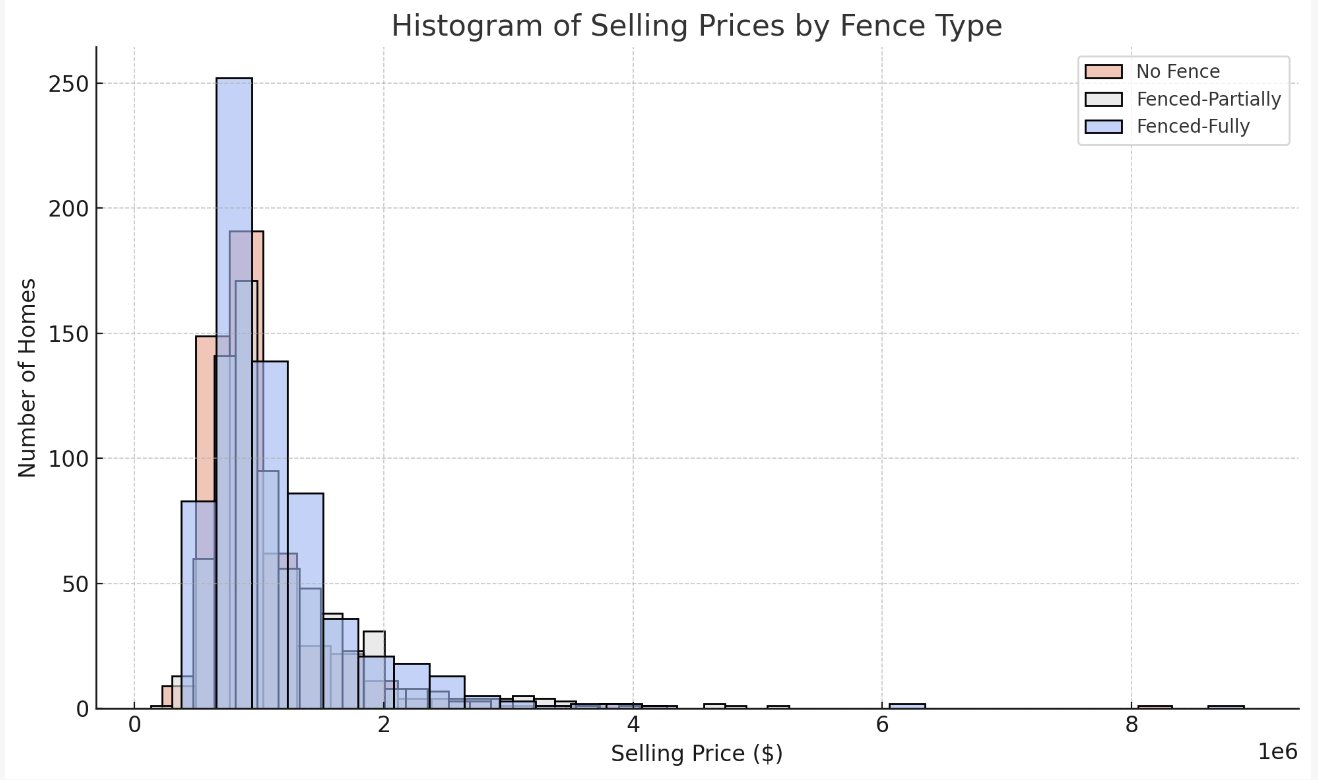
Histogram showcasing the distribution of selling prices by fence type
What the data tells us:
Sale Durations:
- Homes Going Fence-Free: There’s quite a mix here. About half of these homes take anywhere from 4 to 24 days to find a buyer.
- Fully Fenced Homes: These see a more uniform pattern, with half getting picked up in 5 to 20 days.
- Homes with Partial Fencing: They hover closely to their fully fenced buddies, with half being sold between 5 and 19 days.
Extended Sales Times:
- Unfenced Properties: Some of these really tested buyers’ patience, with the record-setter lingering for a whopping 247 days.
- Fully Fenced Retreats: They were quicker off the mark, with the lengthiest sale stretching to 92 days.
- Partially Fenced Dwellings: The one that held out the longest did so for 119 days.
Deciphering the Numbers:
While the median offers us a focal point, examining the DOM spread—from the quicker 25th percentile to the more patient 75th—gives us a more nuanced look into how long homes usually wait before waving goodbye. And interestingly, those open-concept, fence-free homes show the widest swings in waiting times.
Fence data outliers
From our data, a fun fact emerged: Homes with fences, whether partial or full, tend to sell a smidge faster than those without. Here’s a quick breakdown:
- Homes with partial fences: On average, they’re sold in about 14.95 days.
- Homes with full fences: Close behind, these are typically sold in 15.26 days.
- Homes without any fence: These take a bit longer, with an average of 16.92 days on the market.
Fencing and Property Value
Our deep dive into the city’s property data has shed light on some fascinating links between fences and property valuations.
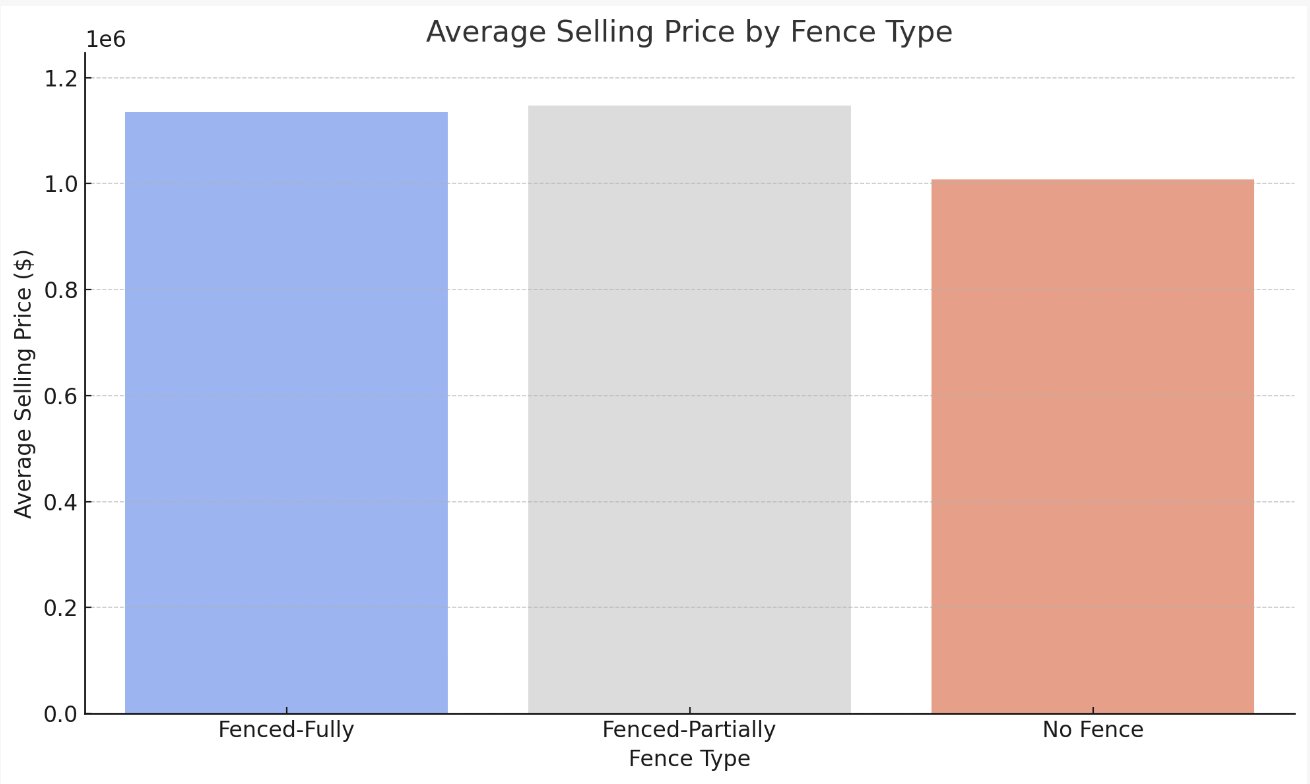
Bar Chart showcasing the Average Selling Price by Fence Type. The differences in selling prices for homes with different fencing types are clearly visible.
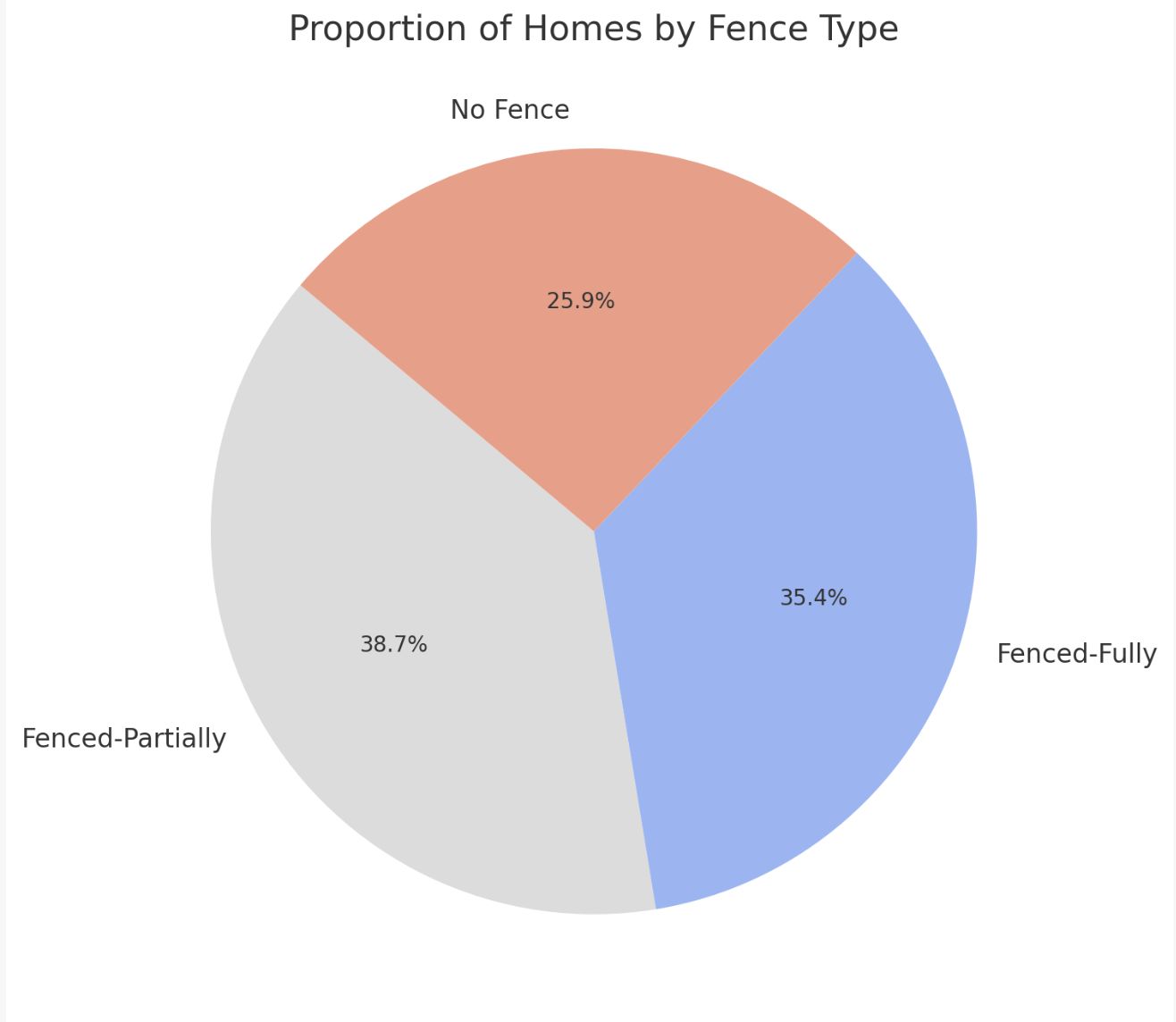
Pie Chart displaying the proportion of homes by fence type
- Homes with Partial Fences: Taking the lead, these properties boast an average selling price of a whopping $1,147,345.
- Fully Fenced Homes: Not far behind, homes enveloped entirely by fences come in at an impressive average of $1,135,093.
- Fence-Free Homes: Homes that opted for an open feel, sans fences, have an average price tag of $1,007,766.
The Takeaway: Whether it’s the allure of added privacy, the charm of a picket fence, or just a safe haven for pets to play, having a fence—partial or full—seems to add not just charm, but also tangible value to homes in Seattle.
Selling Prices by Fence Type: A Detailed Look
Now that we’ve looked at the affect average sale price let’s look at how fences seem to give homes a nudge in price. How does this play out across the spectrum of sales? 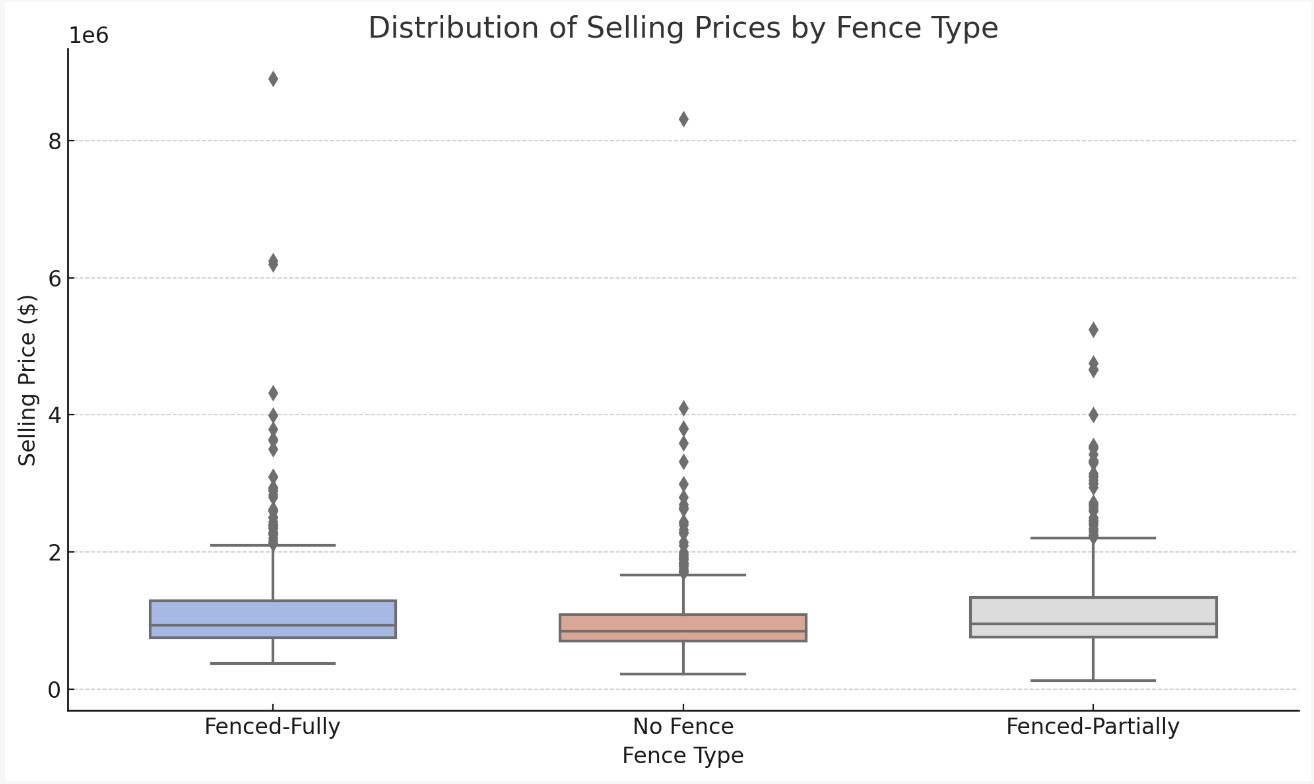
Box plot showing the distribution of selling prices by fence type
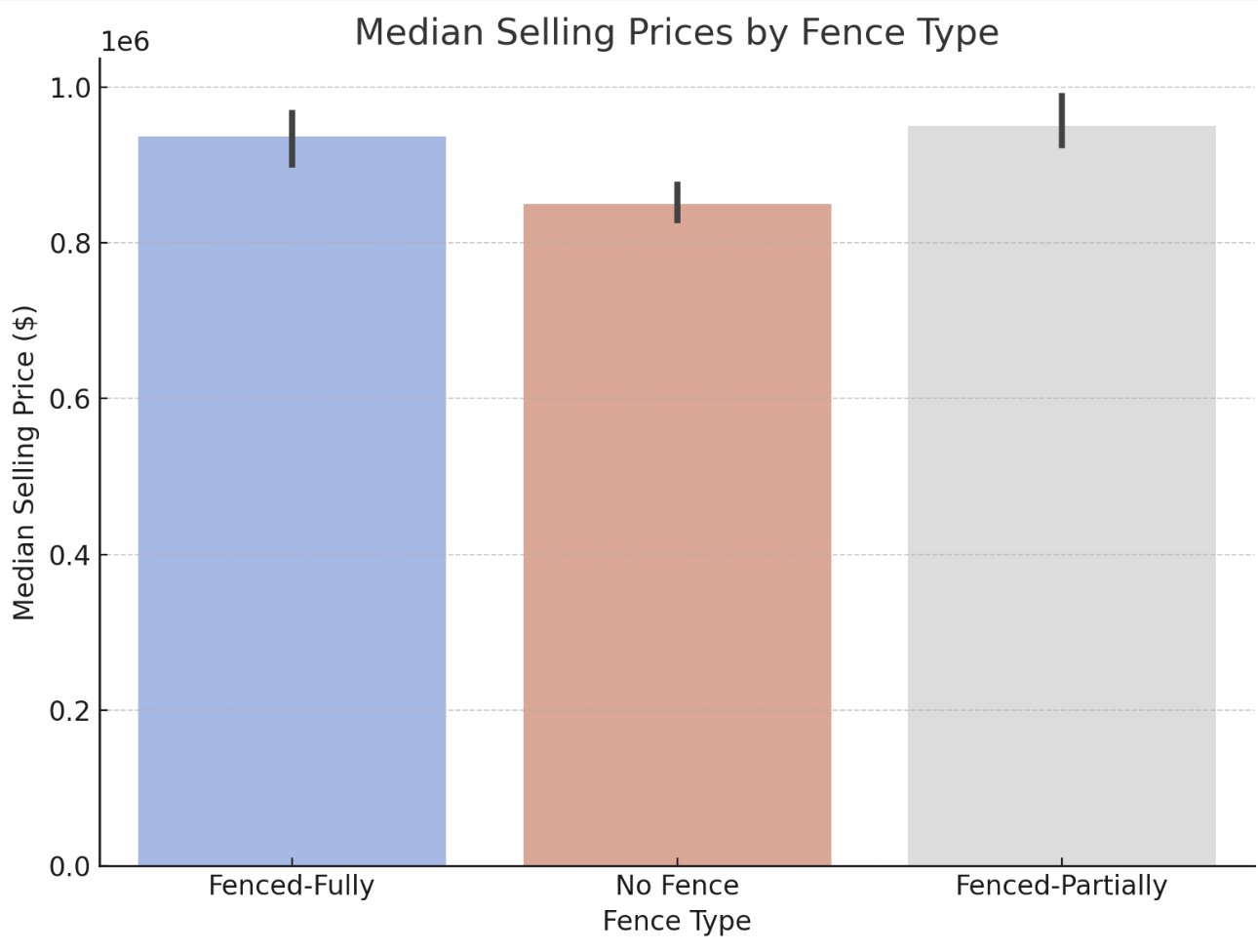
Bar chart showing the median selling prices by fence type

Histogram showcasing the distribution of selling prices by fence type
From our data we find the following:
- Fenced-Fully Homes:
- Median Price: The middle price, where half the homes sell for less and half sell for more, is $937,000.
- Most Common Prices: The middle 50% of homes with full fences sold between $750,000 and $1,290,000.
- Overall Range: Most homes sold between $375,000 and approximately $2,100,000. However, there were some special cases, or outliers, where homes sold for as much as $8,900,000!
- Fenced-Partially Homes:
- Median Price: $950,000.
- Most Common Prices: These homes usually sold between $760,000 and $1,342,500.
- Overall Range: Most homes were priced between $130,000 and roughly $2,216,250. Yet, a few homes stood out, selling for up to $5,250,000.
- Homes Without Fences:
- Median Price: $850,000.
- Most Common Prices: The central cluster of homes without fences sold between $700,000 and $1,087,500.
- Overall Range: These homes generally ranged from $220,000 to about $1,668,750. However, we had some exceptions, like homes selling for a whopping $8,320,000!
From the numbers, it’s evident that homes with fences (either full or partial) have a trend of fetching higher prices compared to those without fences. Additionally, fenced homes, especially those with full fences, also show more variability in their prices.
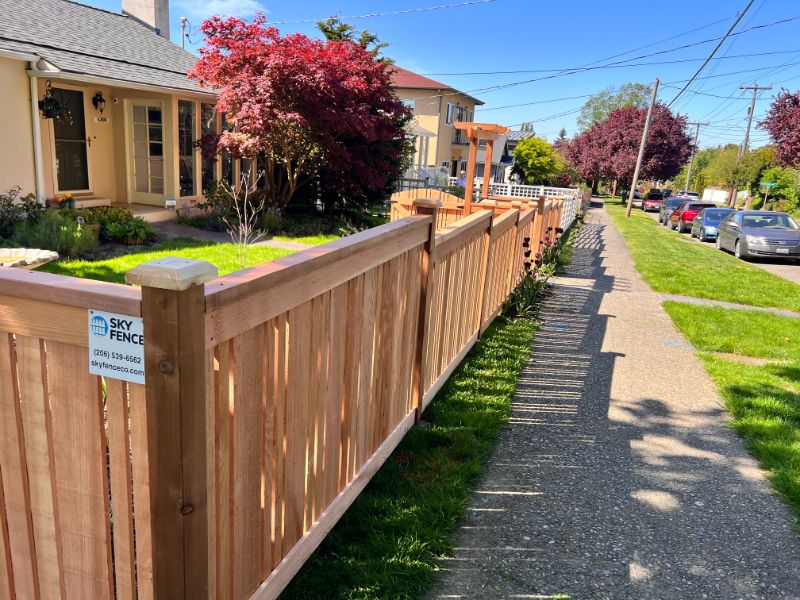
What Do The Experts Say?
It’s not just the data, there are countless testimonials from the experts weighing in on the subject,
Redfin, you may have heard of them:
Replacing your existing fence for a new one can give your yard the boost it needs by enhancing the greenery, ensuring privacy and security, and increasing home value.
Homelight, the real estate experts:
Landscaped homes may sell 1-10% higher, enhancing curb appeal. Fence factors such as length, type, material, permits, and whether it’s done pro or DIY can influence its value. Privacy is crucial for buyers, especially in urban areas, which prefer privacy fences. Well-maintained fences offer personal benefits and curb appeal, and appraisers take condition and buyer preferences into account.
Your friends at Progressive Insurance:
Fences enhance property value, security, privacy, safety, and curb appeal. Materials play a significant role with wood being versatile and affordable, metal variants like steel and aluminum offering their unique benefits, and vinyl fences providing value with minimal maintenance, privacy, and security.
Lawnstarter, home improvement blog:
Well-built fences enhance curb appeal, security, and privacy. Different materials like wood, metal, vinyl, concrete, and composite fences can raise property value by up to 10%. The material, style, height, and design matter for fence value. Secure boundaries, aesthetics, privacy, and curb appeal drive fence value.
iBuyer, matching home buyers and sellers:
A fence can be particularly valuable for certain demographics, such as those aged 35-55, enhancing property worth and lifestyle. For families, a fence can raise the return on investment (ROI) by over 50%, offering benefits like privacy, safety, and aesthetics.
Fences can boost home value by providing privacy, security, and aesthetics. Design, functionality, and practicality are significant determinants. A well-designed fence can add up to 20% value to a property, and landscaped fences alone might add $40,000 to $200,000 in value. Vinyl is particularly suited to luxury homes while wood is adaptable.
The addition of a fence impacts property value, and the purpose, design, and materials used are of utmost importance. Chain-link fences might not provide as much value, but choices like wood, vinyl, and iron can substantially increase value.
Most folks in the real estate and home improvement worlds agree on one thing: fences can seriously boost a property’s value. Whether it’s about making that first impression, giving a sense of privacy, or just a safe spot for little ones and furry friends to play, homebuyers often have fences on their wishlist. Sure, the type and style can tweak the value a bit, but the general feeling is that a well-kept fence is a big plus. So, thinking of sprucing up your space? Adding a fence might be a smart move. After all, both the stats and the pros are hinting at it.
Pros and Cons of Fenced Properties in Seattle’s Housing Market
Advantages of Fenced Properties:
- Higher Sale Price: Homes with full and partial fences tend to have higher median selling prices compared to those without.
- Faster Sales: Fully and partially fenced homes, on average, spend fewer days on the market compared to homes without fences.
- Appeal to Specific Demographics: Fences may appeal to families with young children, pet owners, or those seeking added privacy, potentially expanding the buyer pool.
- Enhanced Security: Fences can provide an additional layer of security, which can be a selling point for many buyers.
- Defined Boundaries: Fences clearly delineate property lines, which can prevent potential disputes with neighbors.
Drawbacks of Fenced Properties:
- Maintenance Costs: Fences require upkeep, which might be a deterrent for some buyers who are concerned about maintenance costs and efforts.
- Aesthetics: Not all buyers may appreciate the look of a fence, especially if it doesn’t align with their aesthetic preferences.
- Potential for Decreased Openness: Some buyers might prefer the open look and feel of a property without a fence, especially in areas with scenic views.
- Cost of Installation: For sellers considering adding a fence before selling, there’s the upfront cost of installation to consider. Consult a real estate professional who knows the Seattle market first. Depending on your situation the ROI may or may not be worth the investment.
- Zoning and HOA Restrictions: Some areas may have restrictions on fence heights, styles, or even whether a fence can be installed.
Conclusion
Seattle’s housing market reveals some intriguing patterns when we delve into properties based on their fencing types:
- Selling Prices: Homes with full fences generally command a premium, with a median price surpassing those of partially fenced or unfenced properties. The median selling price for fully fenced homes is above $600,000, while homes without fences hover around $550,000. This suggests that homeowners might see a return on investment for adding or maintaining a full fence.
- Days on Market (DOM): Homes with a full fence tend to sell the quickest, with an average DOM just above 10 days. Partially fenced homes follow closely, taking about 14 days on average. In contrast, homes without fences linger longer on the market, nearing an 18-day average. This could imply that buyers might prioritize properties with fences due to added privacy, security, or aesthetic appeal.
- Distribution of DOM: While the average DOM provides a centralized view, exploring the distribution of DOM can give a broader perspective. The spread of selling times varied across fence types, indicating diverse buyer preferences and potential seasonal effects.
In summary, fences play a noteworthy role in Seattle’s residential market dynamics. For homeowners contemplating renovations or potential sellers strategizing their listings, understanding the influence of fences can be invaluable. As Seattle continues to evolve, keeping an eye on these patterns might offer insights into future market shifts.
Frequently Asked Questions
What kind of fence adds the most value to a home?
Typically, materials like wood, iron, and vinyl are known to enhance a property’s value more than other options such as chain-link fences. The value addition also depends on the design, functionality, and aesthetics of the fence.
Does a fence increase home value in Seattle specifically?
According to the data from NWMLS, homes in Seattle with full fences generally command a premium compared to unfenced properties. The median selling price for fully fenced homes surpasses that of partially fenced or unfenced properties.
How long does it take for a home with a fence to sell in Seattle?
The average Days on Market (DOM) for homes with a full fence is just above 10 days, indicating that these properties sell quicker than those without fences.
Does the type of fence matter when it comes to property value?
Yes, the type and style of fence can impact the property value. Privacy fences, in particular, are highly valued in urban areas, and well-maintained fences can add to the curb appeal of a property.
What are some other benefits of having a fence?
Aside from potentially increasing property value, fences offer benefits like enhanced privacy, security, and aesthetics. They can also provide a safe space for children and pets, and contribute to the overall curb appeal of a home.
Do buyers prioritize properties with fences?
While buyer’s preferences can vary, data suggests that properties with fences tend to sell quicker, indicating that fences may be a sought-after feature among homebuyers.
Are there any drawbacks of having a fence?
In some cases, fences can be costly to install and maintain, or they may obstruct views that add value to the property. Additionally, certain regulations and HOA rules might affect what types of fences are allowed. It’s important to research these factors before making any decisions.

